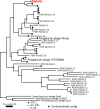A Novel and Ubiquitous Marine Methylophage Provides Insights into Viral-Host Coevolution and Possible Host-Range Expansion in Streamlined Marine Heterotrophic Bacteria
- PMID: 35311512
- PMCID: PMC9004378
- DOI: 10.1128/aem.00255-22
A Novel and Ubiquitous Marine Methylophage Provides Insights into Viral-Host Coevolution and Possible Host-Range Expansion in Streamlined Marine Heterotrophic Bacteria
Abstract
The methylotrophic OM43 clade are Gammaproteobacteria that comprise some of the smallest free-living cells known and have highly streamlined genomes. OM43 represents an important microbial link between marine primary production and remineralization of carbon back to the atmosphere. Bacteriophages shape microbial communities and are major drivers of mortality and global marine biogeochemistry. Recent cultivation efforts have brought the first viruses infecting members of the OM43 clade into culture. Here, we characterize a novel myophage infecting OM43 called Melnitz. Melnitz was isolated independently from water samples from a subtropical ocean gyre (Sargasso Sea) and temperate coastal (Western English Channel) systems. Metagenomic recruitment from global ocean viromes confirmed that Melnitz is globally ubiquitous, congruent with patterns of host abundance. Bacteria with streamlined genomes such as OM43 and the globally dominant SAR11 clade use riboswitches as an efficient method to regulate metabolism. Melnitz encodes a two-piece tmRNA (ssrA), controlled by a glutamine riboswitch, providing evidence that riboswitch use also occurs for regulation during phage infection of streamlined heterotrophs. Virally encoded tRNAs and ssrA found in Melnitz were phylogenetically more closely related to those found within the alphaproteobacterial SAR11 clade and their associated myophages than those within their gammaproteobacterial hosts. This suggests the possibility of an ancestral host transition event between SAR11 and OM43. Melnitz and a related myophage that infects SAR11 were unable to infect hosts of the SAR11 and OM43, respectively, suggesting host transition rather than a broadening of host range. IMPORTANCE Isolation and cultivation of viruses are the foundations on which the mechanistic understanding of virus-host interactions and parameterization of bioinformatic tools for viral ecology are based. This study isolated and characterized the first myophage known to infect the OM43 clade, expanding our knowledge of this understudied group of microbes. The nearly identical genomes of four strains of Melnitz isolated from different marine provinces and the global abundance estimations from metagenomic data suggest that this viral population is globally ubiquitous. Genome analysis revealed several unusual features in Melnitz and related genomes recovered from viromes, such as a curli operon and virally encoded tmRNA controlled by a glutamine riboswitch, neither of which are found in the host. Further phylogenetic analysis of shared genes indicates that this group of viruses infecting the gammaproteobacterial OM43 shares a recent common ancestor with viruses infecting the abundant alphaproteobacterial SAR11 clade. Host ranges are affected by compatible cell surface receptors, successful circumvention of superinfection exclusion systems, and the presence of required accessory proteins, which typically limits phages to singular narrow groups of closely related bacterial hosts. This study provides intriguing evidence that for streamlined heterotrophic bacteria, virus-host transitioning may not be necessarily restricted to phylogenetically related hosts but is a function of shared physical and biochemical properties of the cell.
Keywords: OM43; bacteriophages; cultivation; marine microbiology; virus-host systems.
Conflict of interest statement
The authors declare no conflict of interest.
Figures






Similar articles
-
Genomic diversity and biogeographic distributions of a novel lineage of bacteriophages that infect marine OM43 bacteria.Microbiol Spectr. 2023 Aug 21;11(5):e0494222. doi: 10.1128/spectrum.04942-22. Online ahead of print. Microbiol Spectr. 2023. PMID: 37607063 Free PMC article.
-
Efficient dilution-to-extinction isolation of novel virus-host model systems for fastidious heterotrophic bacteria.ISME J. 2021 Jun;15(6):1585-1598. doi: 10.1038/s41396-020-00872-z. Epub 2021 Jan 25. ISME J. 2021. PMID: 33495565 Free PMC article.
-
Novel phage infecting the Roseobacter CHUG lineage reveals a diverse and globally distributed phage family.mSphere. 2024 Jul 30;9(7):e0045824. doi: 10.1128/msphere.00458-24. Epub 2024 Jun 27. mSphere. 2024. PMID: 38926906 Free PMC article.
-
Phage puppet masters of the marine microbial realm.Nat Microbiol. 2018 Jul;3(7):754-766. doi: 10.1038/s41564-018-0166-y. Epub 2018 Jun 4. Nat Microbiol. 2018. PMID: 29867096 Review.
-
Host-hijacking and planktonic piracy: how phages command the microbial high seas.Virol J. 2019 Feb 1;16(1):15. doi: 10.1186/s12985-019-1120-1. Virol J. 2019. PMID: 30709355 Free PMC article. Review.
Cited by
-
Prokaryotic-virus-encoded auxiliary metabolic genes throughout the global oceans.Microbiome. 2024 Aug 29;12(1):159. doi: 10.1186/s40168-024-01876-z. Microbiome. 2024. PMID: 39198891 Free PMC article.
-
Novel pelagiphage isolate Polarivirus skadi is a polar specialist that dominates SAR11-associated bacteriophage communities at high latitudes.ISME J. 2023 Oct;17(10):1660-1670. doi: 10.1038/s41396-023-01466-1. Epub 2023 Jul 14. ISME J. 2023. PMID: 37452097 Free PMC article.
-
Long-read powered viral metagenomics in the oligotrophic Sargasso Sea.Nat Commun. 2024 May 14;15(1):4089. doi: 10.1038/s41467-024-48300-6. Nat Commun. 2024. PMID: 38744831 Free PMC article.
-
Genomic diversity and biogeographic distributions of a novel lineage of bacteriophages that infect marine OM43 bacteria.Microbiol Spectr. 2023 Aug 21;11(5):e0494222. doi: 10.1128/spectrum.04942-22. Online ahead of print. Microbiol Spectr. 2023. PMID: 37607063 Free PMC article.
References
-
- Brussaard CPD, Wilhelm SW, Thingstad F, Weinbauer MG, Bratbak G, Heldal M, Kimmance SA, Middelboe M, Nagasaki K, Paul JH, Schroeder DC, Suttle CA, Vaqué D, Wommack KE. 2008. Global-scale processes with a nanoscale drive: the role of marine viruses. ISME J 2:575–578. 10.1038/ismej.2008.31. - DOI - PubMed
-
- Weitz JS, Stock CA, Wilhelm SW, Bourouiba L, Coleman ML, Buchan A, Follows MJ, Fuhrman JA, Jover LF, Lennon JT, Middelboe M, Sonderegger DL, Suttle CA, Taylor BP, Frede Thingstad T, Wilson WH, Eric Wommack K. 2015. A multitrophic model to quantify the effects of marine viruses on microbial food webs and ecosystem processes. ISME J 9:1352–1364. 10.1038/ismej.2014.220. - DOI - PMC - PubMed
Publication types
MeSH terms
Substances
Grants and funding
LinkOut - more resources
Full Text Sources

